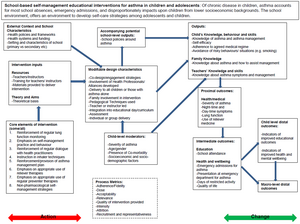This article may need to be rewritten to comply with Wikipedia's quality standards. (February 2010) |

Logic models are hypothesized descriptions of the chain of causes and effects leading to an outcome of interest (e.g. prevalence of cardiovascular diseases, annual traffic collision, etc). While they can be in a narrative form, logic model usually take form in a graphical depiction of the "if-then" (causal) relationships between the various elements leading to the outcome. However, the logic model is more than the graphical depiction: it is also the theories, scientific evidences, assumptions and beliefs that support it and the various processes behind it.[1][2]
Logic models are used by planners, funders, managers and evaluators of programs and interventions to plan, communicate, implement and evaluate them.[3][2] They are being employed as well by health scientific community to organize and conduct literature reviews such as systematic reviews.[4][5] Domains of application are various, e.g. waste management,[6] poultry inspection,[7] business education,[8] heart disease and stroke prevention.[9] Since they are used in various contexts and for different purposes, their typical components and levels of complexity varies in literature (compare for example the W.K. Kellogg Foundation[10] presentation of logic model, mainly aimed for evaluation, and the numerous types of logic models in the intervention mapping framework[11]). In addition, depending on the purpose of the logic model, elements depicted and the relationships between them is more or less detailed.
- ^ Renger R (2002). "A Three-Step Approach to Teaching Logic Models". The American Journal of Evaluation. 23 (4): 493–503. doi:10.1016/s1098-2140(02)00230-8.
- ^ a b Frechtling JA (2015). "Logic Models". International Encyclopedia of the Social & Behavioral Sciences. Elsevier. pp. 299–305. doi:10.1016/b978-0-08-097086-8.10549-5. ISBN 978-0-08-097087-5.
- ^ "Logic Model". Encyclopedia of Evaluation. Sage Publications, Inc. 2005. doi:10.4135/9781412950558.n321. ISBN 978-0-7619-2609-2.
- ^ Anderson LM, Petticrew M, Rehfuess E, Armstrong R, Ueffing E, Baker P, Francis D, Tugwell P (March 2011). "Using logic models to capture complexity in systematic reviews". Research Synthesis Methods. 2 (1): 33–42. doi:10.1002/jrsm.32. PMID 26061598. S2CID 34282960.
- ^ Kneale D, Thomas J, Harris K (2015-11-17). "Developing and Optimising the Use of Logic Models in Systematic Reviews: Exploring Practice and Good Practice in the Use of Programme Theory in Reviews". PLOS ONE. 10 (11): e0142187. Bibcode:2015PLoSO..1042187K. doi:10.1371/journal.pone.0142187. PMC 4648510. PMID 26575182.
- ^ Industrial Economics, Incorporated (IEc) Evaluation Team (2010). Evaluation of the WasteWise Program (PDF). EPA's Office of Policy, Economics, and Innovation.
- ^ Development of a logic model and an evaluation framework of the Canadian Food Inspection Agency's Modernized Poultry Inspection Program. Canada. Health Canada. Food Safety Assessment Program. [Ottawa]. 2003. ISBN 978-0-662-35161-0. OCLC 905371520.
{{cite book}}: CS1 maint: location missing publisher (link) CS1 maint: others (link) - ^ Hense J, Kriz WC, Wolfe J (February 2009). "Putting theory-oriented evaluation into practice: A logic model approach for evaluating SIMGAME" (PDF). Simulation & Gaming. 40 (1): 110–33. doi:10.1177/1046878107308078. S2CID 61673390.
- ^ Sitaker M, Jernigan J, Ladd S, Patanian M (April 2008). "Adapting logic models over time: the Washington State Heart Disease and Stroke Prevention Program experience". Preventing Chronic Disease. 5 (2): A60. PMC 2396971. PMID 18341795.
- ^ W.K. Kellogg Foundation (1998). W.K. Kellogg Foundation Logic Model Development Guide. Battle Creek: W.K. Kellogg Foundation.
- ^ Eldredge LK, Markham CM, Ruiter RA, Kok G, Parcel GS (2016). Planning health promotion programs: an intervention mapping approach (Fourth ed.). San Francisco, CA: John Wiley & Sons. ISBN 978-1-119-03556-5. OCLC 914256995.